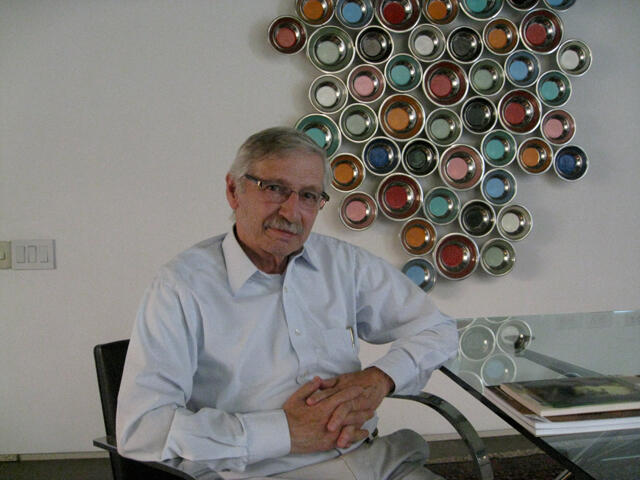Santiago Cárdenas
Freites, Caracas
We had our first approach to the work of Santiago Cárdenas (Colombia, 1937) in Bogotá –inspired by an article by Galaor Carbonell.

In the development of his work we have seen hangers, plays with mirrors, blackboards and other objects, in neutral spaces and spaces featuring colors which are almost monochrome. The gray and white tones, as well as the uniformity of the surface suggested we were in the presence of a Nordic painter – who handled nuances ranging from different qualities of white to grays.
Some time later we met the artist, who stands out for his humility and discretion, contrasting with those artists that exude a star temperament which they are very often not entitled to. Trained in the USA, Cárdenas never ceased to be Colombian. A pupil of Rosenquist and Wesselmann, he shared their teachings with other students such as Richard Serra, Chuck Close, Nancy Graves, Janet Fish and Jennifer Bartlett – all of them big names. But Cárdenas chose to return to his country and develop his work there.
Throughout this trajectory, he has surprised us with each stage we have discovered. There was a phase –of deep color and Matissian influence -, that confused us and that became a new, considerably superior moment in which hyperrealism fused with an underlying expressionism – in which Cárdenas proved that he was also a master of color. Starting out, at the beginning of his career, from Pop Art, Matisse and the Flemish Old Masters, Cárdenas came under the marked influence of Colombian figuration of his time.
In this exhibition of his recent work held in Caracas, the first gaze is one of wonder. Cárdenas’ command of the craft has become consummate. His painting is so impeccable that it appears to tell us that if it does not disturb the viewer, then it is not worthwhile. His are flawless compositions, perfect shadows. All of them are pervaded with an aura of mystery. Oblivious blackboards featuring remote ideas. Or a flower, a simple flower, perhaps levitating, shouting out its solitude and beauty in order to be admired. But thought begins with hesitation. And doubts must grow with age. Because the only thing we know is that there are no more certainties left. The slates – like the rest of the objects – may surprise us. There are no characters, only their traces. And these are perceived in the things that man uses but is not aware of.
Over the course of more than forty years, Cárdenas has gone through many stages, in a process of permanent search. At the end of his career, his wish is to return to his beginnings. There may be differences in the trace. But there is a profound knowledge behind the command of the different techniques. They hold no secrets for the artist. The incursions into color are over. He has gone back to the origin. He says he has the mental strength to work, but not the physical one. And while he used to spend sixteen hours in the studio, currently he cannot resist more than six hours. He also comments he is no longer affected by criticism – which used to be ferocious in Colombia and the United States in past decades. What might be the reason why a master who has proved, throughout his long trajectory, that he is capable of innovating and of renovating himself, should revise his beginnings? These are not questions to be answered by the critics. The artist may not know the reasons. We leave this mystery to the viewer, who is already sufficiently disturbed.






